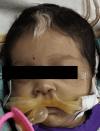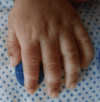Clinical Insights Into Waardenburg-Shah Syndrome: A Case Series and Literature Review
- PMID: 38854277
- PMCID: PMC11157294
- DOI: 10.7759/cureus.59858
Clinical Insights Into Waardenburg-Shah Syndrome: A Case Series and Literature Review
Abstract
Researching Waardenburg syndrome (WS) underscores its rarity and complex symptomatology, presenting as a congenital disorder predominantly inherited in an autosomal dominant pattern. It exhibits incomplete penetrance, which results in a wide range of clinical manifestations, with variable phenotypic presentations within the same family as well. The most commonly found features are facial abnormalities, hypopigmentation of the skin, heterochromia iridis, and conductive deafness. Adding to the eccentricities of this syndrome are its four subtypes, each presenting with its specific clinical features, which helps in delineating the subtype. A mutated paired box 3 (PAX3) gene manifests as type 1 Waardenburg, which is characterized by sideways displacement of the inner angles of the eyes (i.e., dystopia canthorum), widely spaced eyes, congenital sensorineural hearing impairment, and patchy pigmentation of the iris, skin, and hair. Due to insufficient research, it has been difficult to isolate all the genetic mutations responsible for type 2, but its phenotype is very similar to type 1 with minor differences. Type 3 is characterized by musculoskeletal abnormalities. Waardenburg-Shah syndrome (type 4), which is associated with Hirschsprung disease, is the rarest subtype and is caused by genetic mutations in the endothelin receptor type B (EDNRB), endothelin-3 (EDN3), or sex-determining region Y (SRY) box 10 (SOX10) gene. We present a case series of this unique subtype that presented with a typical history of constipation due to Hirschsprung disease and had phenotypic manifestations of white forelock, heterochromia iridis, and bilateral sensorineural hearing loss (SNHL). In parallel with a positive 1° family history of a white forelock, we reflect on the fundamentals of this unique syndrome, as well as its management protocols, highlighting the importance of genetic counseling and cultivation of a high index of suspicion for its diagnosis.
Keywords: case series; congenital disorder; inherited disorder; subtype 4; waardenburg-shah syndrome.
Copyright © 2024, Kankipati et al.
Conflict of interest statement
The authors have declared that no competing interests exist.
Figures
Similar articles
-
Case of Waardenburg Shah syndrome in a family with review of literature.J Otol. 2018 Sep;13(3):105-110. doi: 10.1016/j.joto.2018.05.005. Epub 2018 Jun 8. J Otol. 2018. PMID: 30559775 Free PMC article. Review.
-
Review and update of mutations causing Waardenburg syndrome.Hum Mutat. 2010 Apr;31(4):391-406. doi: 10.1002/humu.21211. Hum Mutat. 2010. PMID: 20127975 Review.
-
A Case of Waardenburg-Shah Syndrome Type 4 Presenting with Bilateral Homochromatic Blue Irises from Pakistan.Cureus. 2018 Aug 14;10(8):e3143. doi: 10.7759/cureus.3143. Cureus. 2018. PMID: 30345200 Free PMC article.
-
Four mutations in MITF, SOX10 and PAX3 genes were identified as genetic causes of waardenburg syndrome in four unrelated Iranian patients: case report.BMC Pediatr. 2021 Feb 8;21(1):70. doi: 10.1186/s12887-021-02521-6. BMC Pediatr. 2021. PMID: 33557787 Free PMC article.
-
Waardenburg Syndrome: A Case Study of Two Patients.Indian J Otolaryngol Head Neck Surg. 2015 Sep;67(3):324-8. doi: 10.1007/s12070-015-0870-3. Epub 2015 Jun 29. Indian J Otolaryngol Head Neck Surg. 2015. PMID: 26405672 Free PMC article.
Cited by
-
Deaf/hard of hearing ecological assessment form-child (DEAF-C).J Deaf Stud Deaf Educ. 2025 Mar 20;30(2):149-157. doi: 10.1093/jdsade/enae054. J Deaf Stud Deaf Educ. 2025. PMID: 40111192 Free PMC article.
-
Waardenburg Syndrome Type 4 in Mongolian Children: Genetic and Clinical Characterization.Int J Mol Sci. 2025 Jun 28;26(13):6258. doi: 10.3390/ijms26136258. Int J Mol Sci. 2025. PMID: 40650035 Free PMC article.
References
-
- White forelock, pigmentary disorder of irides, and long segment Hirschsprung disease: possible variant of Waardenburg syndrome. Shah KN, Dalal SJ, Desai MP, Sheth PN, Joshi NC, Ambani LM. J Pediatr. 1981;99:432–435. - PubMed
-
- Waardenburg syndrome. Read AP, Newton VE. https://doi.org/10.1136/jmg.34.8.656. J Med Genet. 1997;34:656–665. - PMC - PubMed
-
- Shah-Waardenburg syndrome and PCWH associated with SOX10 mutations: a case report and review of the literature. Verheij JB, Sival DA, van der Hoeven JH, Vos YJ, Meiners LC, Brouwer OF, van Essen AJ. https://doi.org/10.1016/j.ejpn.2005.10.004. Eur J Paediatr Neurol. 2006;10:11–17. - PubMed
-
- A novel mutation in the endothelin B receptor gene in a patient with Shah-Waardenburg syndrome and Down syndrome. Boardman JP, Syrris P, Holder SE, Robertson NJ, Carter N, Lakhoo K. https://doi.org/10.1136/jmg.38.9.646. J Med Genet. 2001;38:646–647. - PMC - PubMed
-
- Mutation of the endothelin-3 gene in the Waardenburg-Hirschsprung disease (Shah-Waardenburg syndrome) Edery P, Attié T, Amiel J, et al. Nat Genet. 1996;12:442–444. - PubMed
Publication types
LinkOut - more resources
Full Text Sources




